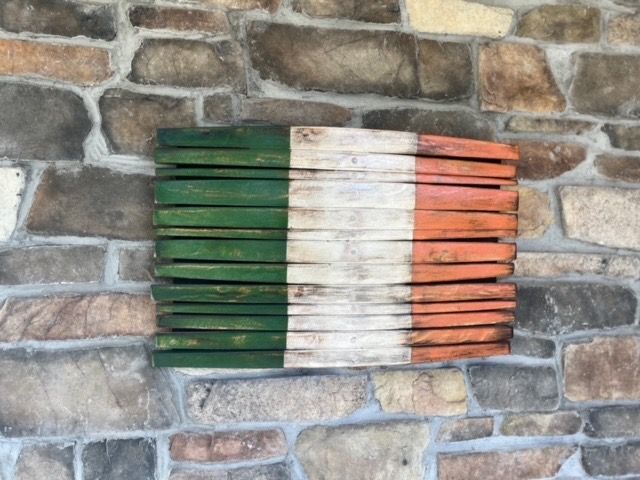Brian McCormick, left, and Chris Heaney during a trip this year to New York. PHOTO BY PETER MCDERMOTT
By Peter McDermott
Twenty-one people work at the Seamus Heaney HomePlace.
“That’s naught to 21 in a very short space of time,” said its manager, Brian McCormick.
Since it opened in late 2016, tens of thousands have visited the attraction in Bellaghy, Co. Derry, dedicated to a poet who, for his “works of lyrical beauty and ethical depth,” was awarded the Noble Prize for Literature in 1995.
His success was measured in other ways, too. The BBC reported, for instance, in 2007 that Heaney's volumes “make up two-thirds of the [UK] sales of living poets.”
The center has a permanent exhibition, a 191-seat performance space and a range of arts and education programs; additionally, in contrast to some of the biggest cultural draws in major cities, including New York, it is open seven days a week.
Van Morrison performed at the Seamus Heaney HomePlace in May; while it had a high-profile visit by President Michael D. Higgins last year and one by Prince Charles and the Duchess of Cornwall in 2017.
“There’s a pride in the area and a pride in Seamus Heaney and his work,” McCormick said of the staff. “They genuinely have a passion for what they do. They do say it’s a labor of love, which is it is for all of us that work there.”
A labor of love, and indeed of intense affection and admiration for a man who was taken from the world when a physically and intellectually active 74-year-old.
“What those of us who have had the privilege of his friendship and presence will miss is the extraordinary depth and warmth of his personality,” President Higgins said following Heaney’s death on Aug. 30, 2013.
New partnerships
The center says in an introductory brochure: “Discover the people who inspired him: his mother, his father, his brother Hugh, his neighbor at the Forge, Barney Devlin, his wife, Marie, his children, Michael, Christopher and Catherine, his grandchildren and Carlo, the family dog!”
McCormick is family too, being the poet’s nephew, and with his first cousin, the above-mentioned Christopher or Chris Heaney, traveled as far as Texas in the spring to bring the good news of an “unmitigated success” and to forge new partnerships, as well as follow up on ones already made.
In the latter category, an official from the Ireland Funds in Dallas had visited Bellaghy and was impressed with what she saw. During their visit McCormick and Heaney were guests at a number of the St. Patrick’s season events in Texas, including one in Waco, where the Nobel laureate himself had given a reading not long before his death.
The delegation included representatives from the Mid Ulster District Council, which provided most of the initial cost of £4.25 million for the Seamus Heaney HomePlace.
Some of the delegation took time out to visit and were duly impressed with the Sixth Floor Museum at Dealey Plaza in Dallas, which is focused on the death of the president on Nov. 22, 1963.
Of course, the Seamus Heaney HomePlace is a space that finds its equivalents more in the John F. Kennedy Presidential Library in Dorchester, Mass., or the Louis Armstrong House in Corona, New York City, or the Emily Dickinson Museum in Amherst, Mass.
The term “HomePlace” carries particular significance given that the work is intimately connected to and filled with references to the locality in which Heaney grew up.
Chris Heaney said that for those who know the work, the landscape is within a five-10 mile radius.
“Toner’s bog in ‘Digging,’ is out the road,” he said, in reference to a poem in his father’s debut collection, “Death of a Naturalist” (1966).
“By God, the old man could handle a spade.
Just like his old man.
“My grandfather cut more turf in a day
Than any other man on Toner’s bog.”
“He was born close to the town,” his son said, on a trip to New York. “He was buried five minutes from the center. It’s very much the start and end of the story.
“The family home is still in family hands,” he added.
“If you’re interested, there’s a lot within striking distance,” McCormick agreed. “We also have plans to develop some of those sites that Chris mentioned. We’re going to develop a trail network, with digital interpretation and some pieces of public art there.
“People can go to those sites at present but we want to make it slightly more accessible without striping away the authenticity,” he said.
The brochure invites the visitor to explore the “places of his childhood and formative years – Anahorish, Mossbawn, Broagh, Toomebridge, Lagan’s Road.”

A visual from the Seamus Heaney HomePlace.
When Heaney, the eldest of nine, was attending the Catholic boarding school St. Columb’s on a scholarship, his father inherited the Wood, and the family moved closer to Bellaghy.
Early in “Stepping Stones” (2008), a 500-page book of interviews with him by fellow poet Dennis O’Driscoll, Heaney recalled in forensic detail the consecutive homes, his life on the farm and the various personalities he recalled from his childhood and youth.
Mossbawn was thatched, as was the Wood in the family’s first years there and O’Driscoll, who predeceased him by eight months, asked about rats referred to in the poem “An Advancement of Learning” and about other sounds heard when in bed at night.
Heaney replied that “there’d often be this scratching and scuttling. Mice, presumably. But every now and again there would a more substantial traveler on the boards, most unwelcome, and we’d presume it to be Mr. Rat. But the comfort sound in the bedroom was the horse beyond the wall. You’d hear these occasional big body rolls and foot stamps in the stable. Big flubby snorts of contentment. There was contentment and security also from the voice of the newsreader on the wireless and talk going in the kitchen. Sometimes a train passed at night, or the dog would bark, maybe at a drunk man out on the road.”
Chris Heaney made frequent childhood trips north with his family starting out from their home in Sandymount, Dublin, where his mother Marie still lives.
“Roads weren’t as good; it was a longer trek then,” he recalled.
“My sister gravitated towards my mum’s area [in County Tyrone], but myself and my brother would stay in the Wood, the family home,” he said. “There were tractors and milking machines, open fields.”
“Disneyland, Bellaghy-style,” McCormick interjected.
Chris Heaney said the visits became less frequent after the death of his grandparents when he was in his teens and these days he defers to his cousin as the “man with the local knowledge.”
A neutral space
“I was brought up four miles from Bellaghy,” Brian McCormick said. “That’s been my patch,”
He goes to work at what was once the site of a heavily-fortified RUC station.
“Thankfully that’s all past,” he said. “We want to ensure it’s a neutral space, because that obviously reflects the man himself, as it were.”
“We were at eye level, socially, with most neighbors,” Heaney told O’Driscoll in “Stepping Stones.”
He referred to a number of Protestant unionist families, some by name – ranging from landless laborers to those who were better off. He said, "We were on very good terms with all of these people.”
One of them in particular, he added, “would have been more or less the same kind of family as we were, in terms of the size of the farm, the nonsectarian disposition of the household, and a general unanxiousness about where they stood.”
As for brothers George and Alan Evans, who appear occasionally in the work, Heaney told O’Driscoll, they were “very easy in their way of going on, very friendly. They had been in the army during the war and brought my father a big set of rosary beads from Rome after they were demobbed. Their remark about having stolen the beads off the Pope’s dresser was much quoted.”
Whereas Patrick Heaney saw himself as much as part of a community of cattle-dealers as of Catholics, his mother Margaret was “more alert to the sectarian strains, readier to be provoked by the hidden operations of the system.”
The visit of Prince Charles and the Duchess of Cornwall would certainly have helped if there were “any lingering doubts,” McCormick said, about the center’s status in a historically divided society.
“We haven’t found any issues with that in any way at all,” he said.
There’s been an update on the prince in 2019, too. “He met Chris’s sister and mentioned Bellaghy,” McCormick reported. “So it left an impression with him. He seemed to really, really enjoy the visit.”
[caption id="attachment_103609" align="alignnone" width="300"]
[/caption]
And they keep on coming, the famous and non-famous — from 22 countries, by the last count. There’s a particular interest in Heaney’s work in Japan and the recent selection “100 Poems” has been translated into Spanish.
“He’s been translated into quite a few languages,” said his son, who lives in Dublin with his family.
But it’s clear most of the interest is in the Anglophone world for the man who at the time of his death was, according to the Independent newspaper in London, “the world’s most famous poet.”
English is the language heard on the audio devices at the Seamus Heaney HomePlace. “People can hear Seamus reading,” McCormick said. “And that’s a very powerful experience.”
English, too, is the focus of the education programs developed for students ages 4 through 18. As part of those, the center has been working with Queen’s University and the University of Ulster on curricula for 17- and 18-year-olds studying for their A-level (state) exams.
McCormick said that the Seamus Heaney HomePlace would also like to work closely with centers and organizations dedicated to the other Irish writers in the pantheon. “We’ve started a conversation with the Yeats Society in Sligo,” he added.
While in New York, where Seamus Heaney was a popular guest at venues like Glucksman Ireland House and the 92nd Street Y, McCormick and his cousin discussed some of the “finer details” of proposals for events in 2020 and 2021. Meantime, there's something on just about every night at the Seamus Heaney HomePlace in Bellaghy. On this Friday, for example, it's "So Sing On with Andy Irvine and Donal Lunny," and on Oct. 6, it's "1000 Books to Read Before You Die with James Mustich."
And during the day, there’s the stream of school and tour buses and visitors by car.
“There’s a lot going on there,” McCormick said on his visit to New York, “That’s for sure.”
Visit the website here.










